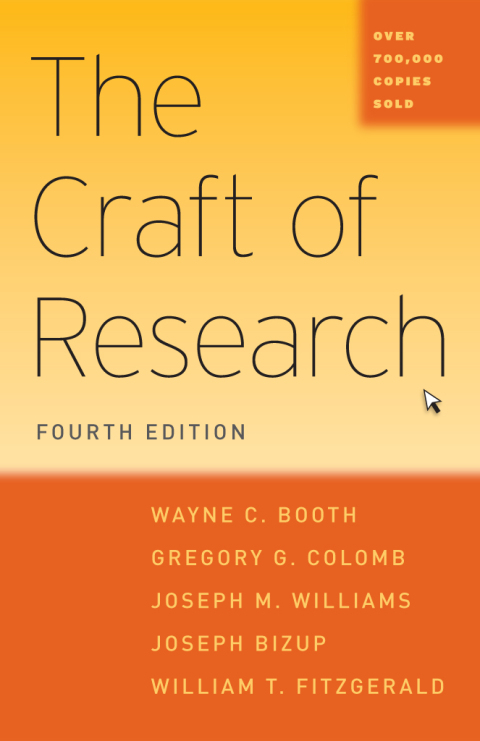Description
Efnisyfirlit
- Cover
- Title Page
- Copyright Page
- Contents
- Preface: The Aims of This Edition
- Our Debts
- Dedication
- I Research, Researchers, and Readers
- Prologue: Becoming a Researcher
- 1 Thinking in Print: The Uses of Research, Public and Private
- 1.1 What Is Research?
- 1.2 Why Write It Up?
- 1.3 Why a Formal Paper?
- 1.4 Writing Is Thinking
- 2 Connecting with Your Reader: Creating a Role for Yourself and Your Readers
- 2.1 Conversing with Your Readers
- 2.2 Understanding Your Role
- 2.3 Imagining Your Readers’ Role
- ★ Quick Tip: A Checklist for Understanding Your Readers
- II Asking Questions, Finding Answers
- Prologue: Planning Your Project—An Overview
- ★ Quick Tip: Creating a Writing Group
- 3 From Topics to Questions
- 3.1 From an Interest to a Topic
- 3.2 From a Broad Topic to a Focused One
- 3.3 From a Focused Topic to Questions
- 3.4 The Most Significant Question: So What?
- ★ Quick Tip: Finding Topics
- 4 From Questions to a Problem
- 4.1 Understanding Research Problems
- 4.2 Understanding the Common Structure of Problems
- 4.3 Finding a Good Research Problem
- 4.4 Learning to Work with Problems
- ★ Quick Tip: Manage the Unavoidable Problem of Inexperience
- 5 From Problems to Sources
- 5.1 Three Kinds of Sources and Their Uses
- 5.2 Navigating the Twenty-First-Century Library
- 5.3 Locating Sources on the Internet
- 5.4 Evaluating Sources for Relevance and Reliability
- 5.5 Looking Beyond Predictable Sources
- 5.6 Using People to Further Your Research
- ★ Quick Tip: The Ethics of Using People as Sources of Data
- 6 Engaging Sources
- 6.1 Recording Complete Bibliographical Information
- 6.2 Engaging Sources Actively
- 6.3 Reading for a Problem
- 6.4 Reading for Arguments
- 6.5 Reading for Data and Support
- 6.6 Taking Notes
- 6.7 Annotating Your Sources
- ★ Quick Tip: Manage Moments of Normal Anxiety
- III Making an Argument
- Prologue: Assembling a Research Argument
- 7 Making Good Arguments: An Overview
- 7.1 Argument as a Conversation with Readers
- 7.2 Supporting Your Claim
- 7.3 Acknowledging and Responding to Anticipated Questions and Objections
- 7.4 Connecting Claims and Reasons with Warrants
- 7.5 Building a Complex Argument Out of Simple Ones
- 7.6 Creating an Ethos by Thickening Your Argument
- ★ Quick Tip: A Common Mistake—Falling Back on What You Know
- 8 Making Claims
- 8.1 Determining the Kind of Claim You Should Make
- 8.2 Evaluating Your Claim
- 8.3 Qualifying Claims to Enhance Your Credibility
- 9 Assembling Reasons and Evidence
- 9.1 Using Reasons to Plan Your Argument
- 9.2 Distinguishing Evidence from Reasons
- 9.3 Distinguishing Evidence from Reports of It
- 9.4 Evaluating Your Evidence
- 10 Acknowledgments and Responses
- 10.1 Questioning Your Argument as Your Readers Will
- 10.2 Imagining Alternatives to Your Argument
- 10.3 Deciding What to Acknowledge
- 10.4 Framing Your Responses as Subordinate Arguments
- 10.5 The Vocabulary of Acknowledgment and Response
- ★ Quick Tip: Three Predictable Disagreements
- 11 Warrants
- 11.1 Warrants in Everyday Reasoning
- 11.2 Warrants in Academic Arguments
- 11.3 Understanding the Logic of Warrants
- 11.4 Testing Warrants
- 11.5 Knowing When to State a Warrant
- 11.6 Using Warrants to Test Your Argument
- 11.7 Challenging Others’ Warrants
- ★ Quick Tip: Reasons, Evidence, and Warrants
- IV Writing Your Argument
- Prologue: Planning Again
- 12 Planning and Drafting
- 12.1 Planning Your Paper
- 12.2 Avoiding Three Common but Flawed Plans
- 12.3 Turning Your Plan into a Draft
- ★ Quick Tip: Work Through Procrastination and Writer’s Block
- 13 Organizing Your Argument
- 13.1 Thinking Like a Reader
- 13.2 Revising Your Frame
- 13.3 Revising Your Argument
- 13.4 Revising the Organization of Your Paper
- 13.5 Checking Your Paragraphs
- 13.6 Letting Your Draft Cool, Then Paraphrasing It
- ★ Quick Tip: Abstracts
- 14 Incorporating Sources
- 14.1 Quoting, Paraphrasing, and Summarizing Appropriately
- 14.2 Integrating Direct Quotations into Your Text
- 14.3 Showing Readers How Evidence Is Relevant
- 14.4 The Social Importance of Citing Sources
- 14.5 Four Common Citation Styles
- 14.6 Guarding Against Inadvertent Plagiarism
- ★ Quick Tip: Indicating Citations in Your Paper
- 15 Communicating Evidence Visually
- 15.1 Choosing Visual or Verbal Representations
- 15.2 Choosing the Most Effective Graphic
- 15.3 Designing Tables, Charts, and Graphs
- 15.4 Specific Guidelines for Tables, Bar Charts, and Line Graphs
- 15.5 Communicating Data Ethically
- 16 Introductions and Conclusions
- 16.1 The Common Structure of Introductions
- 16.2 Step 1: Establishing a Context
- 16.3 Step 2: Stating Your Problem
- 16.4 Step 3: Stating Your Response
- 16.5 Setting the Right Pace
- 16.6 Organizing the Whole Introduction
- 16.7 Finding Your First Few Words
- 16.8 Writing Your Conclusion
- ★ Quick Tip: Titles
- 17 Revising Style: Telling Your Story Clearly
- 17.1 Judging Style
- 17.2 The First Two Principles of Clear Writing
- 17.3 A Third Principle: Old Before New
- 17.4 Choosing between the Active and Passive Voice
- 17.5 A Final Principle: Complexity Last
- 17.6 Spit and Polish
- ★ Quick Tip: The Quickest Revision Strategy
- V Some Last Considerations
- The Ethics of Research
- A Postscript for Teachers
- Appendix: Bibliographical Resources
- Index







Reviews
There are no reviews yet.